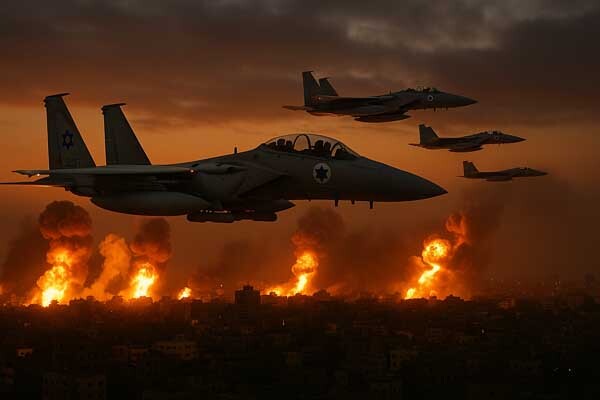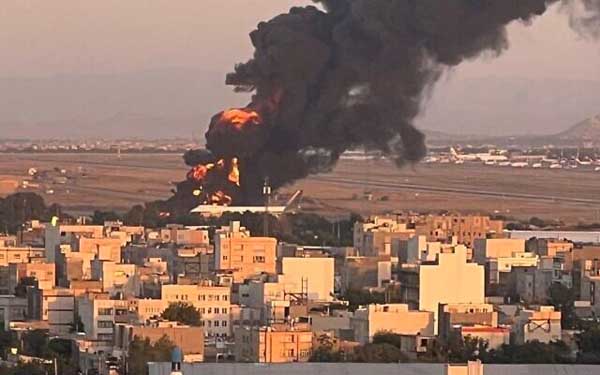
DLNews World at War
More than 200 Israeli warplanes launched a coordinated attack on over 100 military and nuclear sites in Iran late Friday night, shaking the foundations of the Islamic Republic’s defenses. By Saturday afternoon, the Israeli military declared it now held "freedom of action" across Iranian airspace, including routes all the way to Tehran. The world has been left asking whether this historic military strike on the mullahs' terror state will make the region—and the world—safer.

An Iranian refueling plane is seen on fire at Mashhad Airport in northeast Iran following an Israeli strike on June 15, 2025.
The reason for Israel’s sudden and sweeping action lies in the growing urgency over Iran’s nuclear ambitions. The International Atomic Energy Agency issued a resolution Thursday confirming that Iran had violated nuclear agreements and was found to have undeclared atomic material. Just days earlier, the independent military research institute ISIS had warned that within three weeks, Iran could produce enough weapons-grade uranium to build nine nuclear warheads. A senior official from the Israel Defense Forces said that Iran had gone beyond uranium enrichment, with intelligence confirming the regime was actively developing detonators and explosive systems. That, the official said, constituted an existential and immediate threat to Israel. The Israeli Air Force targeted Iran’s critical nuclear research facilities in Natanz and Isfahan, delivering what officials described as significant damage to Tehran’s nuclear infrastructure.
The Middle East Peace Forum observed that Israel had chosen a strategic moment to strike. With Iran’s terrorist proxies—Hamas, Hezbollah, Syria’s Assad regime, and the Houthis—currently weakened, the window for a high-impact operation had opened. The Israeli objective, according to terrorism experts, extended beyond turning off the nuclear program. The mission also sought to eliminate high-ranking officers of Iran’s Islamic Revolutionary Guard Corps and weaken the core of Iran’s strategic leadership.
Whether U.S. President Donald Trump was informed in advance has become a central question. While publicly distancing himself from the strike, Trump is believed to have privately authorized the operation. Axios reported that Israel had received a “clear green light” from Washington. Two Israeli sources confirmed that the green light came shortly after Trump’s 60-day ultimatum to Iran for a civilian-only nuclear agreement expired. The Israeli strike came just one day past that deadline.
Striking nuclear facilities is always fraught with risk, but Israel carefully avoided the most dangerous sites—namely, Iran’s reactors in Arak, Bushehr, and Tehran. These were left untouched to prevent a radioactive catastrophe. Instead, the strikes focused on enrichment and research centers. Both Iranian officials and IAEA representatives confirmed that only minor radioactive leaks had occurred.

In the streets of Tehran and beyond, some Iranians were seen celebrating the deaths of their country’s notorious generals. The Iranian regime quickly responded with internet shutdowns in an attempt to suppress growing unrest. Raz Zimmt, head of the Iran department at Israel’s INSS think tank, suggested that if fractures continue to appear among the Iranian political elite and military leadership, mass civilian action could erupt. He warned that if millions of Iranians conclude the regime can no longer maintain control, regime change is no longer unthinkable. The mullah regime, long the financial and ideological engine of Middle Eastern terrorism, now faces a deep legitimacy crisis. Without the support of its people, the government may be on the verge of collapse. Analysts at NAFFO noted that regime change in Tehran could transform the region for the better. Some Gulf monarchies, they added, are quietly signaling support for Israel’s actions.
Whether this triggers a wider war is still uncertain. Iran has threatened to strike all U.S. military bases in the region should America interfere more directly. At the same time, Israel has delivered warnings to Hezbollah, Iraqi militias, and the Houthis that any missile launched at Israeli soil would provoke a swift and overwhelming response.
So far, the United States and Russia have kept their powder dry. The White House has reiterated that it was not directly involved in the airstrikes. However, military experts confirm U.S. forces provided targeting intelligence and assisted in intercepting kamikaze drones launched from Iran. The destroyer USS Thomas Hudner is currently moving from the Mediterranean to the Persian Gulf to bolster defenses. But if Iran crosses a line—say, by hitting a U.S. airfield or sinking an American ship—Trump may be forced into military retaliation. Meanwhile, Russia, despite having received Iranian drones and missiles for its war in Ukraine, has only offered verbal support. With its military bogged down on the Eastern front, Putin’s regime is unlikely to come to Iran’s rescue.
There’s also a global economic cost. Since the strikes began, gas and diesel prices have continued to climb. Crude oil rose sharply from $60 a barrel to $73. Any escalation targeting Iran’s oil production facilities would likely send prices skyrocketing even further.
Security experts are now watching for the next moves from Iran’s military and political leadership. Peter Neumann, a respected terrorism researcher at King’s College London, noted that Iran’s loss of senior IRGC personnel could create both an intelligence vacuum and a dangerous unpredictability in the days to come.
Institutes like ISIS, NAFFO, and INSS are tracking both the fallout and the long-term effects on global non-proliferation and Middle Eastern stability. While the initial Israeli strike appears tactically successful, the world is holding its breath. Whether this was a masterstroke that derails Iran’s nuclear ambitions—or the opening salvo in a much larger and more dangerous conflict—remains to be seen.
Iran has warned that any US intervention will result in missile strikes on American bases in the region. For now, the clash remains largely bilateral. But with Hezbollah in Lebanon, militias in Iraq, and the Houthis in Yemen all watching closely, Israel has made it clear that any proxy retaliation will be met with overwhelming force.
The financial toll is already being felt at the pump. Crude oil surged from $60 to $73 per barrel within 24 hours of the attack. With markets bracing for more volatility, further strikes on Iranian oil infrastructure could send global fuel prices skyrocketing.
Despite the immediate tactical success, the broader question remains: Did Israel’s daring raid avert a nuclear catastrophe, or light the fuse for a larger regional war? For now, the operation has exposed Iran’s vulnerabilities, emboldened its internal critics, and redrawn the region’s strategic map. But whether the world is safer or just holding its breath remains to be seen.

At Desert Local News, connections are everything. We're not just another social networking platform—we're a lively hub where people from all walks of life come together to share stories, spark ideas, and grow together. Here, creativity flourishes, communities grow stronger, and conversations spark global awareness.
Comments